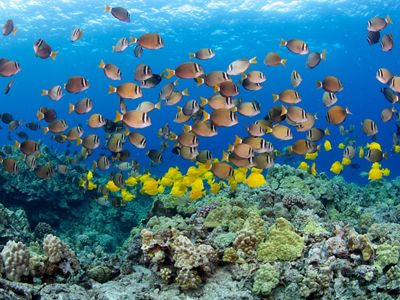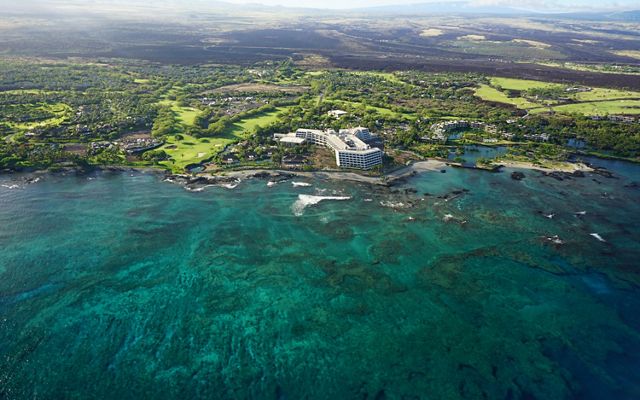Major Upgrade to First U.S. Coral Reef Insurance Policy Increases Coverage and Enables More Robust Post-Storm Response
Hawai‘i’s Pioneering Reef Insurance Policy Renewal Demonstrates Increasing Interest in Reducing Climate Risks Using Nature-Based Solutions
Media Contacts
-
Alessandra Clark
Global Media Relations Manager
Email: alessandra.clark@tnc.org -
Evelyn Wight
Senior Communications Manager in Hawai‘i
Email: ewight@tnc.org
Today, The Nature Conservancy (TNC) announces the purchase of a new coral reef insurance policy that expands coverage around the main Hawaiian islands and increases payouts after qualifying storms. This replaces the first U.S. coral reef insurance policy purchased in 2022.
Hawai‘i’s new policy covers all the main Hawaiian islands and adds 314,976 square kilometers (121,613 miles) to the coverage area to capture more storm events. The maximum payout total is $2 million over the year-long policy period, and $1 million per storm. The minimum payout has doubled to $200,000, an amount that enables a more meaningful post-storm response. The policy is triggered when tropical storm winds of 50 knots or greater occur in the core of the coverage area. Although storms did not trigger the policy in 2022-2023, the new policy is needed as the impacts of the climate crisis increase.
Quote
Hawai‘i’s reefs are essential to the state’s economic and cultural well-being and are the islands’ first line of defense during storms, reducing up to 97% of wave energy.
More companies bid on the new policy this year, demonstrating an increasing interest among insurance companies in nature-based solutions to protect against climate impacts. TNC developed the new policy with WTW and selected an insurance carrier of the Munich Re Group from seven competitive bids.
Hawai‘i’s reefs are essential to the state’s economic and cultural well-being and are the islands’ first line of defense during storms, reducing up to 97% of wave energy. Coral reefs provide flood protection to people, property and jobs valued at more than $836 million and contribute more than $1.2 billion through reef-related tourism to the state’s economy each year. But wave action generated by increasingly intense storms fueled by climate change can quickly devastate coral reefs, reducing their ability to provide the benefits of flood risk reduction, tourism and recreation, fisheries and cultural well-being. Research shows that severe hurricanes can cause up to a 50% loss of live coral cover, and the loss of just one meter of reef height would more than double the annual expected flood damages.


In 2023, TNC convened a post-storm reef response coalition that developed an initial statewide early warning and rapid response plan. The plan guides first responders in reef repair and restoration so the work can commence quickly in the event of an insurance payout. The coalition is comprised of scientists and reef managers from the Hawai‘i Department of Land and Natural Resources Division of Aquatic Resources, universities and local organizations. The committee also worked with local teams to develop specific response plans within Hawai‘i’s four counties. As policy holder, TNC will disburse funds to partners for reef damage assessments and rapid restoration after qualifying storms trigger payouts.
“We are building something that can be really transformative for communities and ecosystems as we respond to increasing storm activity associated with the climate crisis,” says Ulalia Woodside Lee, executive director, The Nature Conservancy, Hawai‘i and Palmyra. “The first policy provided momentum to develop response plans and partnerships. With these now in place and an increased minimum payout, we will be able to start damage assessments and reef repairs after a storm as soon as it’s safe to get in the water. This is important because corals must be reattached within several weeks after breaking or they will likely die.”
TNC will lead a training workshop with coalition organizations this year to establish and train responders on standardized methods for rapid response and coral reattachment in Hawai‘i. The local workshop and standards will incorporate global restoration expertise and lessons learned from post-storm repair on the Mesoamerican reef and other places.

“Thanks to the 2023 partnership work and planning, we are all better prepared to respond quickly after a storm, with agreements in place with groups who have the required skills and permits to repair corals,” says Brian Nielson, Hawai‘i Department of Land and Natural Resources Division of Aquatic Resources administrator. “Our next steps include working closely with more communities around the islands to increase our collective response capacity.”
“Parametric insurance is increasingly demonstrating value in addressing disaster risk for natural assets, in this case providing Hawai‘i with a tangible solution to quickly finance post-storm restoration activities that help reefs better recover and maintain resilience in the face of increasing climate impacts,” says Simon Young, senior director in WTW's Disaster Risk Finance and Parametrics team. “Increasing recognition of this value by conservation organizations, government bodies and other stakeholders on the demand side and by insurers on the supply side is mainstreaming parametric protections, driving accessibility and sustainability.”
Quote: Ulalia Woodside Lee
We are building something that can be really transformative for communities and ecosystems as we respond to increasing storm activity associated with the climate crisis.
René Mück, Munich Re’s global head of natural catastrophe parametrics, adds: “Using parametric risk transfer as a means to contribute to TNC’s conservation objectives in Hawai‘i aligns exactly with the objectives of Munich Re’s parametric business unit. We are proud to support TNC in Hawai‘i and appreciate the work with WTW on such initiatives.”
Recent advances in reef insurance and expansion of the model to new geographies and ecosystems (e.g., mangroves) is raising awareness and interest in the use of these integrated solutions to address the impacts of climate change. The sector seems poised for rapid growth in the coming years. As demonstrated by an ~$850,000 payout from the world’s first reef insurance policy in Quintana Roo, Mexico, to repair damage from Hurricane Delta in 2020, these policies provide critical funding for post-storm response when it is most needed—immediately following a damaging event—to maintain the protective capacity of incredibly valuable natural infrastructure.
Lee concludes: “We would like to thank the Howden Foundation and the Bank of America Charitable Foundation, as well as anonymous private donors, for enabling reef insurance policy development. With their help, we are building resilience to climate change.”
###
For more information visit our Insuring Nature page.
Photos and b-roll available here.
The Nature Conservancy is a global conservation organization dedicated to conserving the lands and waters on which all life depends. Guided by science, we create innovative, on-the-ground solutions to our world’s toughest challenges so that nature and people can thrive together. We are tackling climate change, conserving lands, waters and oceans at an unprecedented scale, providing food and water sustainably and helping make cities more sustainable. The Nature Conservancy is working to make a lasting difference around the world in 81 countries and territories (40 by direct conservation impact and 41 through partners) through a collaborative approach that engages local communities, governments, the private sector, and other partners. To learn more, visit nature.org or follow @nature_press on X.
